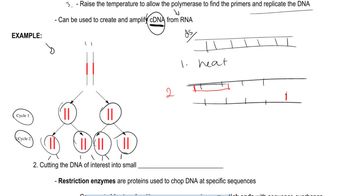Table of contents
- 1. Introduction to Genetics51m
- 2. Mendel's Laws of Inheritance3h 37m
- 3. Extensions to Mendelian Inheritance2h 41m
- 4. Genetic Mapping and Linkage2h 28m
- 5. Genetics of Bacteria and Viruses1h 21m
- 6. Chromosomal Variation1h 48m
- 7. DNA and Chromosome Structure56m
- 8. DNA Replication1h 10m
- 9. Mitosis and Meiosis1h 34m
- 10. Transcription1h 0m
- 11. Translation58m
- 12. Gene Regulation in Prokaryotes1h 19m
- 13. Gene Regulation in Eukaryotes44m
- 14. Genetic Control of Development44m
- 15. Genomes and Genomics1h 50m
- 16. Transposable Elements47m
- 17. Mutation, Repair, and Recombination1h 6m
- 18. Molecular Genetic Tools19m
- 19. Cancer Genetics29m
- 20. Quantitative Genetics1h 26m
- 21. Population Genetics50m
- 22. Evolutionary Genetics29m
18. Molecular Genetic Tools
Genetic Cloning
Problem 32c
Textbook Question
In humans, congenital heart disease is a common birth defect that affects approximately 1 out of 125 live births. Using reverse transcription PCR (RT-PCR) Samir Zaidi and colleagues [(2013) Nature 498:220.223] determined that approximately 10 percent of the cases resulted from point mutations, often involving histone function. To capture products of gene expression in developing hearts, they used oligo(dT) in their reverse transcription protocol.
Compared with oligo(dT) primers, a pool of random sequence primers requires a trickier assessment of annealing temperature. Why?
 Verified step by step guidance
Verified step by step guidance1
<span>Understand the role of primers in reverse transcription: Primers are short sequences that provide a starting point for DNA synthesis. In reverse transcription, they are used to initiate the synthesis of complementary DNA (cDNA) from an RNA template.</span>
<span>Recognize the difference between oligo(dT) primers and random sequence primers: Oligo(dT) primers are composed of a string of thymine nucleotides and specifically anneal to the poly-A tail of mRNA molecules, ensuring that only mRNA is reverse transcribed. Random sequence primers, on the other hand, are a mixture of short sequences that can anneal to various sites along the RNA, including non-polyadenylated RNA.</span>
<span>Consider the annealing temperature: The annealing temperature is critical for primer binding. Oligo(dT) primers have a uniform sequence, which allows for a more predictable and consistent annealing temperature. In contrast, random sequence primers have a variety of sequences, which can result in a wide range of melting temperatures (Tm), making it more challenging to determine the optimal annealing temperature.</span>
<span>Assess the specificity and efficiency: Oligo(dT) primers provide high specificity for mRNA due to their binding to the poly-A tail, whereas random primers can bind to any complementary sequence, potentially leading to non-specific binding and amplification. This variability requires careful optimization of annealing conditions to ensure efficient and specific cDNA synthesis.</span>
<span>Conclude with the implications for experimental design: When using random sequence primers, researchers must carefully optimize the annealing temperature to balance specificity and efficiency, which can be more complex compared to using oligo(dT) primers. This complexity arises from the diverse binding sites and melting temperatures of the random primers.</span>
Recommended similar problem, with video answer:
 Verified Solution
Verified SolutionThis video solution was recommended by our tutors as helpful for the problem above
Video duration:
47sPlay a video:
Was this helpful?
Key Concepts
Here are the essential concepts you must grasp in order to answer the question correctly.
Reverse Transcription PCR (RT-PCR)
RT-PCR is a laboratory technique used to convert RNA into complementary DNA (cDNA) using the enzyme reverse transcriptase. This process allows researchers to amplify specific RNA sequences, making it easier to study gene expression. In the context of congenital heart disease, RT-PCR can help identify mutations affecting gene function, which may contribute to the condition.
Recommended video:
Guided course

Eukaryotic Transcription
Oligo(dT) Primers vs. Random Sequence Primers
Oligo(dT) primers are short sequences of thymidine that specifically bind to the poly-A tail of mRNA, allowing for the selective amplification of mRNA transcripts. In contrast, random sequence primers bind to various RNA sequences, making their annealing less predictable. This variability in binding can complicate the assessment of optimal annealing temperatures, as the melting temperature will differ based on the specific sequences present.
Recommended video:
Guided course

Sequencing Overview
Annealing Temperature in PCR
The annealing temperature in PCR is the temperature at which primers bind to their complementary DNA sequences. It is crucial for the specificity and efficiency of the amplification process. For oligo(dT) primers, the annealing temperature can be more easily determined due to their uniformity, while random primers require careful optimization because their binding sites can vary widely, leading to a broader range of melting temperatures.
Recommended video:
Guided course

Genetic Cloning

 7:43m
7:43mWatch next
Master Genetic Cloning with a bite sized video explanation from Kylia Goodner
Start learningRelated Videos
Related Practice

